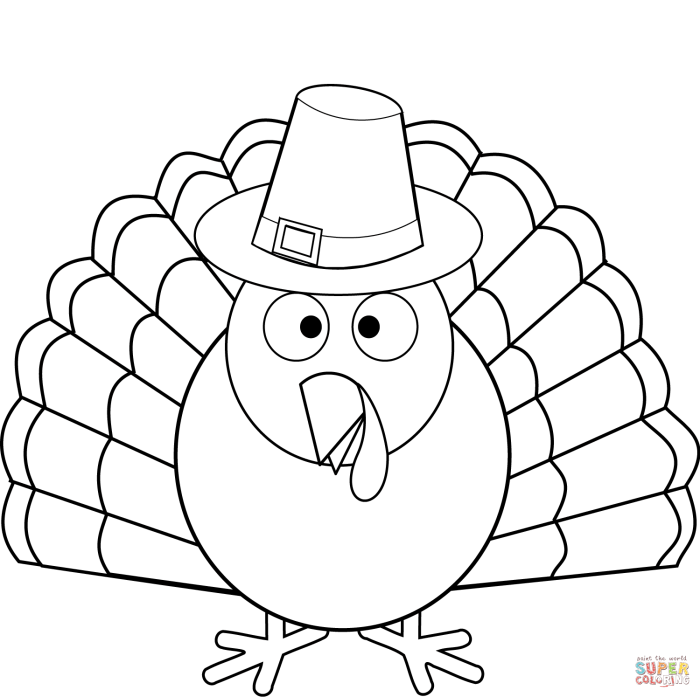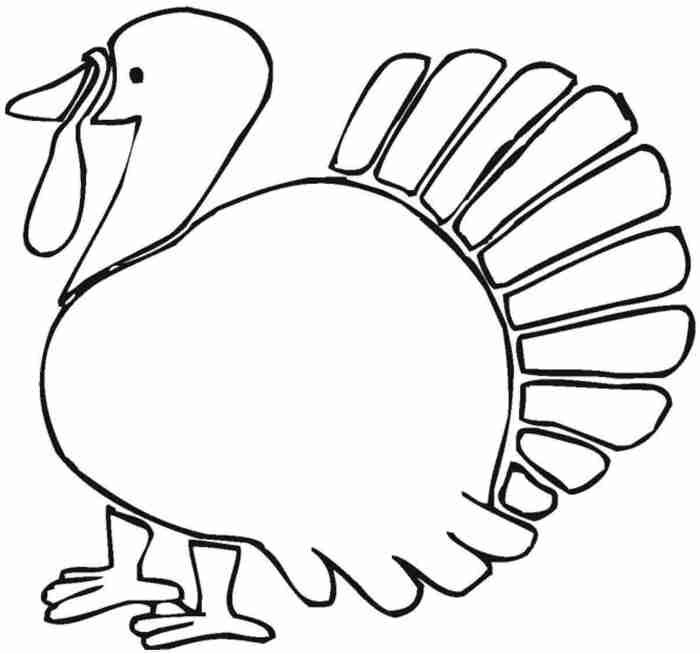Printable Turkey Coloring Page Designs
Printable turkey coloring page – This section details five distinct turkey coloring page designs, catering to various skill levels and preferences. Each design offers a unique approach to depicting turkeys, incorporating varying levels of detail and stylistic choices. These designs can be easily adapted for personal use or incorporated into educational materials.
Realistic Turkey Coloring Page
This design depicts a turkey in a photorealistic style. The feathers are meticulously detailed, showing individual barbs and variations in color. The head is accurately rendered, showcasing the characteristic wattle and snood. The body is depicted in a natural, relaxed posture, with the tail feathers fanned slightly. The background is left blank to allow for creative expression, perhaps depicting a forest or farmland setting.
The overall complexity makes it suitable for older children and adults who enjoy detailed coloring projects.
Cartoonish Turkey Coloring Page
This design features a simplified, cartoon-style turkey. The body is round and plump, with exaggerated features. The feathers are simplified into smooth, bold shapes, and the legs are short and stubby. The turkey has a large, friendly smile and perhaps oversized eyes. This design is perfect for younger children who appreciate simpler, more playful designs.
Thanksgiving-Themed Turkey Coloring Page
This design incorporates classic Thanksgiving elements alongside the turkey. The turkey is positioned centrally, possibly wearing a pilgrim hat or surrounded by pumpkins, cornucopias, and autumn leaves. The design could also feature other Thanksgiving symbols like a harvest basket or a Thanksgiving dinner table. The complexity can be adjusted to suit different age groups; younger children might appreciate simpler shapes, while older children could handle more intricate details.
Finding a printable turkey coloring page for your child’s Thanksgiving craft is easy, but if they’re also into video games, you might consider expanding their options. For instance, you could also check out some exciting alternatives like metal sonic coloring pages , which offer a different kind of creative fun. Afterwards, return to the classic charm of the printable turkey coloring page for a nice balance of themes.
Toddler-Friendly Turkey Coloring Page
This design is specifically created for toddlers, featuring bold, large shapes and simple lines. The turkey is depicted with large, round body, simplified feathers, and oversized feet. The colors are bright and contrasting, making it easy for young children to color within the lines. The simplicity encourages creativity and helps develop fine motor skills.
Intricate Turkey Coloring Page
This design showcases a highly detailed turkey with intricate feather patterns, textures, and shading variations. The background could include a detailed forest scene or a complex geometric pattern. This design challenges older children and adults who enjoy complex coloring projects and allows for a high level of artistic expression. Fine details in the feathers and surrounding environment provide an opportunity for creative shading and blending of colors.
Coloring Page Variations

Creating a diverse range of turkey coloring pages ensures broader appeal and caters to different skill levels and preferences. Variations in pose, expression, background, size, and line weight significantly impact the overall visual interest and the coloring experience.The following sections detail several ways to achieve this variety, offering specific examples to illustrate the possibilities.
Turkey Poses
Different poses can add dynamism and visual interest to the coloring page. A turkey walking serenely across a field presents a calmer image, while a turkey pecking at the ground depicts a more active scene. A turkey in flight, wings outstretched, offers a more challenging and visually stimulating design, requiring more detailed rendering of feathers and wing structure.
These varied poses provide options for different age groups and skill levels. For example, a younger child might prefer the simpler walking turkey, while an older child might enjoy the challenge of the flying turkey.
Turkey Expressions
The expression of the turkey adds personality and charm. A happy turkey, with a wide, friendly smile and bright eyes, evokes a positive feeling. A sleepy turkey, with its eyes half-closed and head tilted, provides a cute and comforting image. Conversely, a grumpy turkey, with furrowed brows and a downturned beak, offers a more humorous and expressive design.
These varying expressions provide opportunities for creative interpretation and personalization by the colorer.
Background Options
The background setting significantly impacts the overall mood and context of the coloring page. A classic farm setting, with barns, fences, and other farm animals, provides a familiar and comforting backdrop. A forest setting, with trees, bushes, and perhaps other woodland creatures, offers a more natural and adventurous feel. A plain background, devoid of any additional elements, allows the turkey to be the central focus, simplifying the coloring experience and emphasizing the details of the turkey itself.
The choice of background can be tailored to the intended age group and complexity of the design.
Coloring Page Sizes
Varying the size of the coloring page offers flexibility and caters to different preferences. A half-page turkey allows for easier handling and coloring, particularly suitable for younger children. A full-page turkey provides ample space for detail and creative expression. Multiple turkeys on a single page could encourage creativity and allow for comparative coloring exercises, comparing different poses or expressions. The size choice directly influences the level of detail that can be incorporated into the design.
Line Weights, Printable turkey coloring page
Utilizing varying line weights adds depth and visual interest to the turkey design. Thicker lines can be used to Artikel the main body parts, providing a strong foundation for the drawing. Thinner lines can be used for finer details, such as feathers, beak, and wattle, adding subtle texture and complexity. This contrast in line weight guides the colorer and enhances the overall aesthetic appeal of the finished product.
A careful balance of line weights can elevate a simple design into a visually rich and engaging piece.
Printable File Formats & Considerations: Printable Turkey Coloring Page

Choosing the right file format for your printable turkey coloring page is crucial for ensuring high-quality prints and a smooth user experience. Different formats offer varying advantages and disadvantages regarding image quality, file size, and compatibility with different printers and software. Understanding these differences will help you optimize your coloring page for both digital distribution and printing.
File Format Comparison
The three most common file formats for printable images are PDF, JPG, and PNG. Each has its strengths and weaknesses when it comes to coloring pages.
| File Format | Advantages | Disadvantages | Best Use Case |
|---|---|---|---|
| PDF (Portable Document Format) | Preserves vector graphics and text formatting; maintains high resolution regardless of scaling; widely compatible across different operating systems and software; prevents accidental edits; good for professional printing. | Larger file size compared to JPG and PNG; requires dedicated software to view and edit; may not be ideal for web display due to size. | Professional printing, ensuring consistent quality across various printers and devices. |
| JPG (JPEG – Joint Photographic Experts Group) | Smaller file size compared to PDF and PNG; widely supported by web browsers and software; suitable for online sharing and web display. | Lossy compression can reduce image quality, especially with intricate details; not ideal for images with sharp lines or text. | Web display, online sharing, situations where file size is a primary concern. |
| PNG (Portable Network Graphics) | Supports lossless compression, preserving image quality; handles sharp lines and text well; supports transparency. | Larger file size compared to JPG; may not be as widely supported as JPG for older systems. | Coloring pages with fine details, images requiring transparency (e.g., overlays). |
Ensuring Correct Print Size
To ensure your coloring page prints at the intended size, set the correct dimensions in your image editing softwarebefore* saving the file. Most software programs allow you to specify the dimensions in inches or centimeters. You should also select the correct page size (e.g., letter, A4) in your printer settings. Using the “print preview” function before printing is highly recommended to verify the size and layout.
Consider adding bleed (extra space around the edges) if printing professionally to account for slight shifts during cutting.
Preparing for Professional Printing
For professional printing, preparing your file requires attention to detail. High-resolution images (at least 300 DPI) are essential for sharp, clear prints. Use CMYK color mode instead of RGB for better color accuracy on professional printing presses. Ensure your file is saved in the correct format (PDF is usually preferred). Consult with your printer for specific file requirements and recommendations.
Printing on Different Paper Types
Cardstock offers a more durable and visually appealing surface for coloring pages, resulting in a more professional finish. The thicker weight of cardstock prevents bleed-through, particularly with wet media like markers or watercolors. Regular paper is a more economical option, but may result in bleed-through with certain coloring mediums. Consider the intended use and coloring materials when choosing paper type.
Thicker papers, such as cardstock, are better suited for robust coloring techniques.
Illustrative Descriptions of Turkey Features

Understanding the physical characteristics of a turkey is key to accurately depicting them in a coloring page. This section provides detailed descriptions of various turkey features, focusing on aspects relevant to artistic representation.
Turkey Feather Texture
The texture of a turkey’s feathers varies depending on their location on the bird’s body. The body feathers are generally smooth and somewhat soft, with a slightly downy undercoat providing insulation. However, the feathers of the tail and breast are notably different. The tail feathers are long, broad, and relatively stiff, creating a striking fan-like appearance. The breast feathers, especially in male turkeys (toms), are often quite broad and have a more robust, almost bristly texture.
These feathers are often iridescent, contributing to the overall visual impact of the bird.
Turkey Wattle and Snood
The wattle and snood are fleshy, pendulous structures found on a turkey’s head and neck. The wattle is the lobe of skin hanging from the underside of the beak, while the snood is a similar structure extending from the forehead, often curving over the beak. Both are highly vascularized, meaning they contain a large number of blood vessels. This accounts for their vibrant color, which can range from a dull red to a bright crimson, depending on the turkey’s health, mood, and temperature.
Their texture is smooth and somewhat fleshy, often described as soft and pliable.
Turkey Plumage Color Variations
Wild turkeys exhibit a range of color variations in their plumage. The overall coloration is typically a mix of browns, blacks, and grays, providing excellent camouflage in their natural woodland habitat. Males generally have a more striking appearance than females, often showcasing iridescent bronze, green, copper, and even blue hues on their breast feathers. Females (hens) tend to be more subdued in coloration, with a pattern of browns and grays that helps them blend seamlessly into their environment.
Color variations can also exist within different subspecies of turkeys.
Turkey Beak and Feet
A turkey’s beak is strong and slightly hooked, adapted for scratching the ground in search of food. It’s typically a grayish-horn color, though some variations in shade are possible. The texture is hard and somewhat rough. The feet are strong and sturdy, with three toes pointing forward and one pointing backward, providing excellent traction for walking and scratching.
They are usually a reddish-gray color, often with a rough, scaly texture.
Turkey Feather Markings and Patterns
The markings and patterns on a turkey’s feathers contribute significantly to their overall appearance. The body feathers often exhibit a mottled pattern of browns, blacks, and grays, providing effective camouflage. The tail feathers, however, are typically more uniform in color, often with a distinct barring pattern of dark and light bands. The breast feathers of males frequently display iridescent markings that shift in color depending on the angle of the light.
These markings are not just for aesthetic appeal; they also play a role in courtship displays and communication among turkeys.
